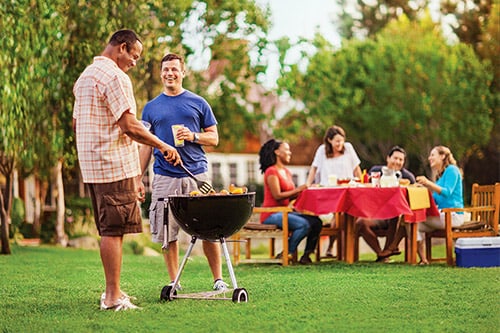The summer sun can do wonders for your lawn, but hot, dry conditions present challenges, too. Check out our guide for summer lawn care.


The summer sun can do wonders for your lawn, but hot, dry conditions present challenges, too. Check out our guide for summer lawn care.

But an unexpected bout of hot, dry weather can present some tough challenges when it comes to properly maintaining your lawn. Consider this your how-to guide on summer lawn care!
In the summertime, it’s easy to get swept up in daydreams of short, perfectly manicured lawns. But by allowing your grass to grow a little bit taller, your lawn will grow deeper roots and look fuller. Additionally, the longer blades will offer more shade of coverage for the soil and help prevent weed germination.
The optimum height for a lawn depends on a number of factors, including grass type and your region. In general, we recommend the ⅓ rule, which says to let your turf grow ⅓ of an inch longer than its optimum height before you cut.
Cool-season grasses, such as Kentucky bluegrass, fescue, and rye, typically do well between 2.5 and 4 inches. These grasses are more common in the Mountain, Midwest, and Northern regions.
Warm-season grasses, such as zoysia, bermuda, and kikuyu are usually kept slightly shorter, between 1 and 3 inches. You’ll find these grass types in the Southern, Transition, Western, and Florida regions.
For recommendations specific to your lawn, our TruGreen PhD certified specialists will conduct a Healthy Lawn Analysis to determine the right height for your turf needs to thrive.
When the summer temperatures start to heat up, it’s essential that your lawn is well watered.
In order to reduce the amount of evaporation, water before the sun is at its highest point. By watering earlier in the day, you’ll also give the lawn ample time to absorb the moisture before it gets dark.
Just like mowing, the optimal watering schedule depends on region and weather. But when the weather turns hot and dry, it’s best to give your lawn around 1 to 2 inches of water per week.
When deciding how much water your lawn needs, think about the layout of your yard, too. Remember that lawns dry out faster when placed near paved surfaces, on slopes, and in areas exposed to more sunlight.
What is drought stress?
A lawn experiences drought stress when the grass loses more water through its leaves than it absorbs through its roots. The resulting insufficient water supply leads to symptoms of stress.
Drought stress is serious business. The resulting over-dryness prevents your grass from growing and can even harm the leaf’s cellular structure. Once the lack of moisture causes the structure to collapse, you’ll likely see long-term or permanent damage to your lawn.
Signs of drought stress
In order to make sure you avoid the harsh repercussions of drought stress, keep a close eye on your lawn for the following signs of drought stress.
Changes in color
Drought can seriously interfere with any ambitions for green grass during the summer. If your grass is suffering from drought stress, you’ve likely already noticed shades of yellow, tan, or brown coloration.
If the blades are turning tan, your lawn is likely in a state of drought-induced dormancy. In this condition, a lawn copes with the severe dry heat by essentially shutting down.
Changes in hue
In addition to changes in color, your lawn’s hue may shift from a vibrant green to a dull gray or blue-green.
Impressions
A lack of moisture means grass blades lose their springy quality that allows them to bounce upright after being pressed down. If this is the case for your lawn, you’ll notice that footprints, lawn mower tracks, and other impressions from objects will remain visible.
Always keep an eye out for impressions during the summer, as they’re one of the earliest signs of drought stress.
Crunching and crackling
If your grass feels and sounds crunchy underfoot (even if it’s still green in color), it may be too dry due to drought stress.
Wilting
As they lose water, grass blades fold in the heat. This is an easy-to-spot sign that your lawn simply isn’t receiving enough moisture.
If you’re worried about drought stress, it may be time to call in the professionals. We can help you set up an irrigation plan that’s tailored to your specific lawn.
There’s no better feeling than watching your family enjoy their time outside on your lawn. But when the fun wraps up for the evening, make sure the kids’ toys and pool floaties don’t stay on the lawn. This applies to other outdoor accessories and pieces of furniture, too.
This will protect your lawn from developing dead patches and create a more polished look for your overall backyard.
Still feeling overwhelmed at the prospect of summer lawn care? Let us help.

Facebook
X
Youtube
Copy Link
Email